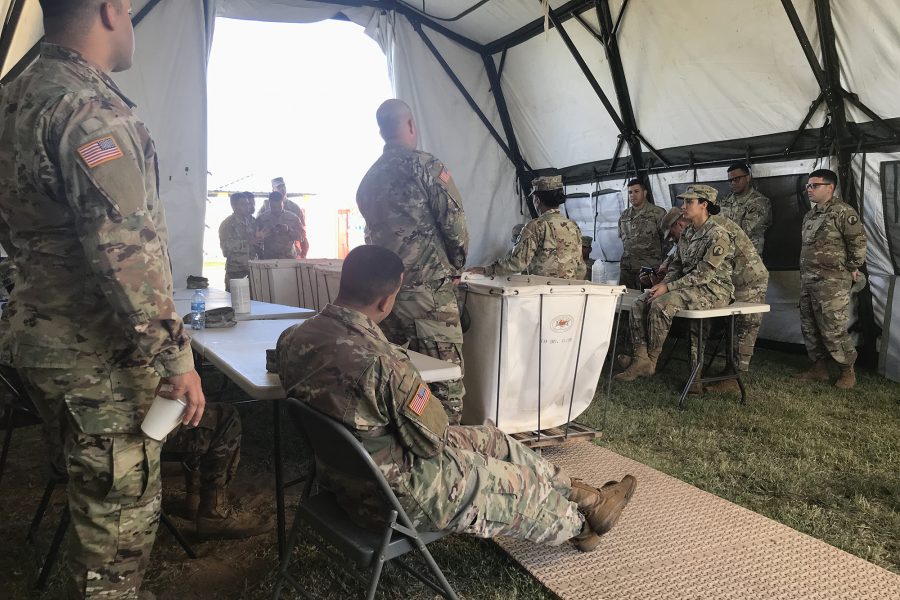CAROLINA, Puerto Rico— More than two weeks after the most severe in an ongoing series of earthquakes rocked Puerto Rico, 1,386 troops are on the ground assisting in the US territory’s recovery.
The troop presence includes more than 800 Puerto Rico Army and Air National Guard members, approximately 150 Army Reservists, and more than 200 members of the Puerto Rico State Guard—a Title 5 force that can be activated by its governor to supplement the territory’s National Guard in limited capacities—Maj. Gen. José Reyes, the territory’s adjutant general, told Air Force Magazine in a Jan. 22 interview at San Juan Army National Guard Aviation Support Station.
It also includes 50 RED HORSE airmen from Ohio and New Mexico, a handful of reinforcements from California, and personnel from US Army North, US Northern Command, and the National Guard Bureau, noted Brig. Gen. Miguel Mendez, the dual status commander in charge of the earthquake response mission. In this capacity, the PRARNG land component commander has been given Title 10 authorization to command Active Duty, Guard, and Reserve troops assisting with the territory’s recovery.
The military has set up camps for internally displaced residents in five municipalities—Guánica, Guayanilla, Peñuelas, Ponce, and Yauco.

“We currently are up and operating and receiving displaced citizens in those five municipalities,” Mendez told Air Force Magazine in a Jan. 21 interview at US Army Garrison Fort Buchanan, which is located near San Juan.
The Department of Housing of Puerto Rico is administering the civilian side of the camps, but troops are providing support services.

Photo: Jennifer-Leigh Oprihory/staff
“We are in charge of doing the security, cooking, laundry, and washer services, and also supporting the Department of Housing in the event that they need [it],” he said.
Air National Guard RED HORSE airmen helped set up tent cities near the camps where troops could temporarily live during the project using Disaster Relief Beddown Systems provided by the Ohio Air National Guard. According to the 179th Airlift Wing, these systems provide “basic necessities such as shelter, latrines, and shower facilities and can support up to 300 people.”

“These tents can pretty much stand up to Iraq and all the heavy winds and all that, so they’re still able to move and to go along with it, but there’s no structures to fall on top of us—it’s a nice, clear area—so it’s reinforced really well,” SrA. Elizabeth Kriel, an Ohio ANG airman with the 200th RED HORSE Squadron’s Det. 1, told Air Force Magazine in an interview conducted on the sidelines of the construction efforts on Jan. 19. “The quakes really shouldn’t affect it too much.”

Mendez said the military is also providing security in multiple towns affected by the quakes, securing or supplementing existing security in correctional facilities near Ponce, helping to manage distribution points “in several municipalities in the southwest of the island,” and getting “commodities from … state or federal warehouses” to people in affected communities.
Utilities have been almost completely restored in the hardest-hit areas of the territory, but there’s still work to be done, with “a little over 7,000” residents still displaced as of Jan. 22, Reyes said.
According to Reyes—who was also tasked with coordinating Defense Department, Puerto Rico civilian agency, and Federal Emergency Management Agency response efforts after a state official was abruptly fired on Jan. 18 over corruption allegations—water has been completely reestablished in earthquake-impacted cities, and electricity is 99 percent of the way there.
However, the list of support requests that have come in for DOD, the territory’s civilian agencies, and FEMA to divide up and conquer contained around 2,000 line items as of Jan. 22, he said during the interview. Ninety to 95 percent of these line items have been tasked thus far.
